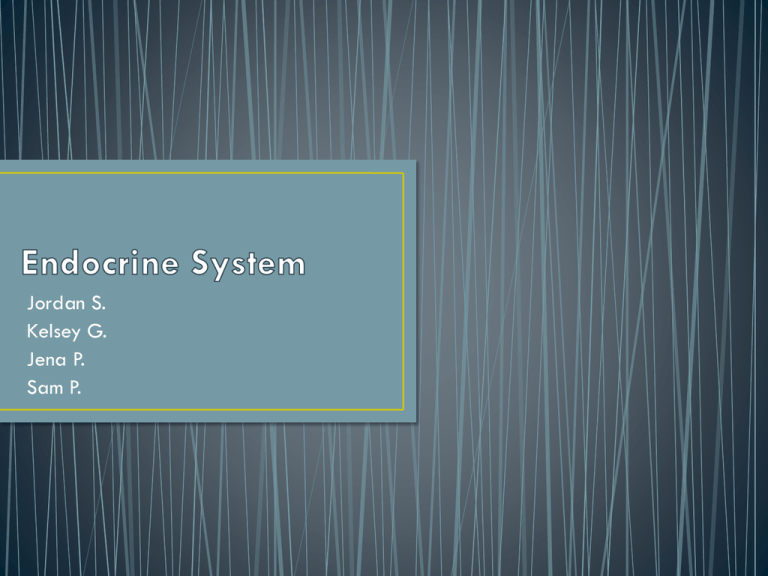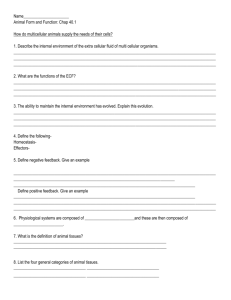Endocrine System
advertisement

Jordan S. Kelsey G. Jena P. Sam P. • A network of glands that secrete hormones, which travel in the bloodstream and affect the functioning of target cells • Work alongside the nervous system • Maintaining homeostasis throughout the body through feedback mechanisms Endocrine Exocrine • Secrete hormones into • Secrete fluids out of the internal the body environment • Ex: Sweat and oils • Diffuse into the interstitial fluid into the bloodstream and act on target cells • Most are steroids synthesized from cholesterol • Or they are amines, peptides, proteins or glycoproteins produced from amino acids, or non-steroid hormones • Stimulate changes in target cells • Cannot dissolve in water but can in lipid • Thus allowing them to enter through the target cell membrane • Steroid bonds to a receptor and triggers transcription of specific regions of DNA resulting in mRNA • Weakly bound to plasma • Released in large quantities near their target cells • https://www.youtube.com/watch?v=CaMKuXKZ70g • • • • Usually bind receptors in target cell membranes Activates adenylate cylase Then catalyzes conversion of ATP to cAMP cAMP promotes a series of reactions leading to cellular changes linked with the hormones action • These hormones do not penetrate the cell membrane into the nucleus as steroid hormones do • Nervous system works to control secretion within the endocrine system • Nerve impulse is transmitted through the neuron • Reaches the glandular cells to secrete a hormone into the bloodstream or to stop the hormone • Hormone responds to target cells • Has no effect on other cells • Endocrine glands are located in: oBrain oThroat oUpper abdominal region oPelvic Region • Secrete hormones internally Located at the base of the brain where the pituitary stalks connect it to the hypothalamus Anterior Posterior • Growth hormone • Prolactin • Thyroid Stimulating hormone • Adrenocorticotropic hormone • Follicle stimulating hormone • Luteinizing hormone • Antidiuretic hormone • Oxytocin • Attached to the pituitary gland by the pituitary stalk • In charge of releasing the nerve impulses to the posterior pituitary which then signals the hormone release • Controls the secretion of the anterior pituitary • Thyrotropic releasing hormone • Corticotropin releasing hormone • Located just below the larynx on either side and in front of the trachea • Thyroxine • Triodothyronine • Calcitonin • Consists of 2 parts: adrenal medulla and the adrenal cortex • The adrenal glad is located right above the kidneys Adrenal Medulla Adrenal Cortex • Epinephrine • Norepinephrine • Aldosterone • Cortisol • Sex hormones • 2 Main reproductive organs that secrete important hormones are the ovaries and testes • Located in the pelvic region of the body Ovaries • Estrogen • Progesterone Testes • Testosterone • Digestive juice secreting exocrine gland • A hormone secreting endocrine gland located posterior to the stomach and behind the parietal peritoneum • Glucagon • Insulin • Located deep between the cerebral hemispheres • Attaches to the upper portion of the thalamus • Melatonin • Usually 4 parathyroid glands • Located on the posterior surface of the thyroid gland • Parathyroid hormone(PTH) • Lies in the mediastinum posterior to the sternum and between the lungs • Large in young kids but shrinks after puberty and with age • Thymosins • A way of controlling hormone secretion • An endocrine gland or system controlling it senses the concentration of the hormone the gland secretes, a process the hormone controls, or an action the hormone has on the internal environment • Diabetes: person has high blood glucose • Insulin production in inadequate or the body’s cells do not respond properly to insulin, or both • Adrenocortical Carcinoma: rare disease in which malignant(cancer) cells form in the outer layer of the adrenal gland • Growth Disorders • body produces too much growth hormone, gigantism or acromegaly can occur •Too little growth hormone results a condition called growth hormone deficiency • Can cause children to grow more slowly than normal








